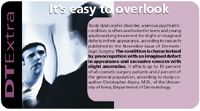- Acne
- Actinic Keratosis
- Aesthetics
- Alopecia
- Atopic Dermatitis
- Buy-and-Bill
- COVID-19
- Case-Based Roundtable
- Chronic Hand Eczema
- Chronic Spontaneous Urticaria
- Drug Watch
- Eczema
- General Dermatology
- Hidradenitis Suppurativa
- Melasma
- NP and PA
- Pediatric Dermatology
- Pigmentary Disorders
- Practice Management
- Precision Medicine and Biologics
- Prurigo Nodularis
- Psoriasis
- Psoriatic Arthritis
- Rare Disease
- Rosacea
- Skin Cancer
- Vitiligo
- Wound Care
Article
Several revision options can improve scars appearance
FortWorth, Texas - The appearance of most scars can be dramatically improved using resurfacing or ablative types of scar revision, according to Eric M. Finley, M.D., who spoke on this topic at the Texas Dermatological Society's Fall CME meeting here.

The first step in revising a scar is.to categorize the scar by asking the.following questions:
The next step is to determine the cause of the scar. It may be due to cutaneous surgery or trauma, such as a car accident or ear piercing. Or, the scar may be the end result of an inflammatory skin process, such as acne or chicken pox.
"I mainly do resurfacing or ablative types of scar revision, and the bulk of the scar revisions that I do are limited, local, postsurgical scars where patients want the scar to be a little bit more cosmetically appealing," says Dr. Finley, head of dermatologic surgery at the Ochsner Clinic Foundation, New Orleans.
His procedure of choice is spot dermabrasion. Ideally, this procedure.is done six to eight weeks after the.initial trauma. A second dermabrasion is rarely necessary; however, if performed, it is done six months after the first. If erythema persists after the first dermabrasion, Dr. Finley will perform two or three pulsed dye laser treatments beginning three months after the spot dermabrasion. The pulsed dye laser treatments will be done every six weeks until an acceptable result is achieved.
"We can save patients dramatic surgical procedures by using a flashlamp-pumped pulsed dye laser," he says.The Food and Drug Administration cleared this as an approved treatment for erythematous and hypertrophic scars in the mid 1990s.
"I use the pulsed dye laser frequently to get erythema out of scars and to gently and subtly remodel the texture of the scar tissue. Each treatment will decrease the erythema and improve the texture in a very subtle and gradual manner. Most of the post-surgical scars that I treat with the pulsed-dye laser require two to three treatments to reach their endpoint," he says.
However, dramatic scars on the verge of being keloidal scars can take numerous treatments. In fact, Dr. Finley says that some of these scars may require 10 to 12 treatments with the pulsed-dye laser. These types of scars are usually symptomatic. They can itch, sting and burn, and these symptoms are often the motivation for treatment, rather than the appearance of the scar. The pulsed-dye laser can be very effective in eliminating the symptoms even if the scar tissue is not dramatically altered.
The flashlamp-pumped pulsed dye laser can augment the effect of intralesional corticosteroids.
"Some authors have suggested that there is a certain synergy with those two treatments that is greater than the sum of the two individual treatments," Dr. Finley explains.
Other treatments Fillers can also play a role in atrophic scar revision. According to Dr. Finley, fillers used for this purpose include collagen, hyaluronic acid, Sculptra (Aventis), Radiance (Bioform Inc.), ePTFE, autologous fat, silicone and.others. The excimer laser may provide additional options to these patients.
Massage has also been used, although it has no evidence-based support. Most studies evaluating the effect of massage have focused on burn patients who go to physical therapy for structured massage.
"However, there is evidence in the literature to suggest that silicone gel sheeting works. Its mechanism is unclear but postulated to be hydration of the underlying scar by reducing evaporative water loss. This is thought to decrease capillary activity and thus reduce collagen.deposition/scar hypertrophy," he says.
Newsletter
Like what you’re reading? Subscribe to Dermatology Times for weekly updates on therapies, innovations, and real-world practice tips.














